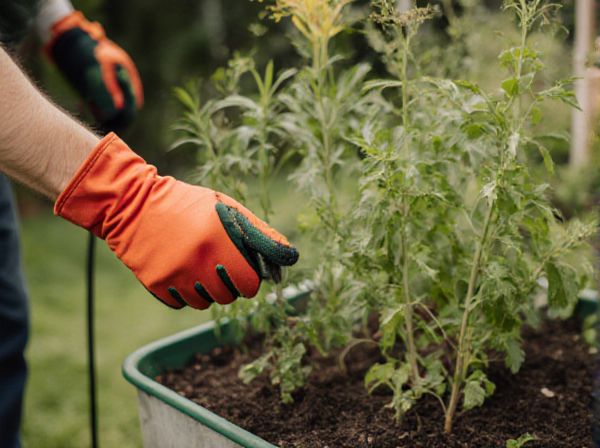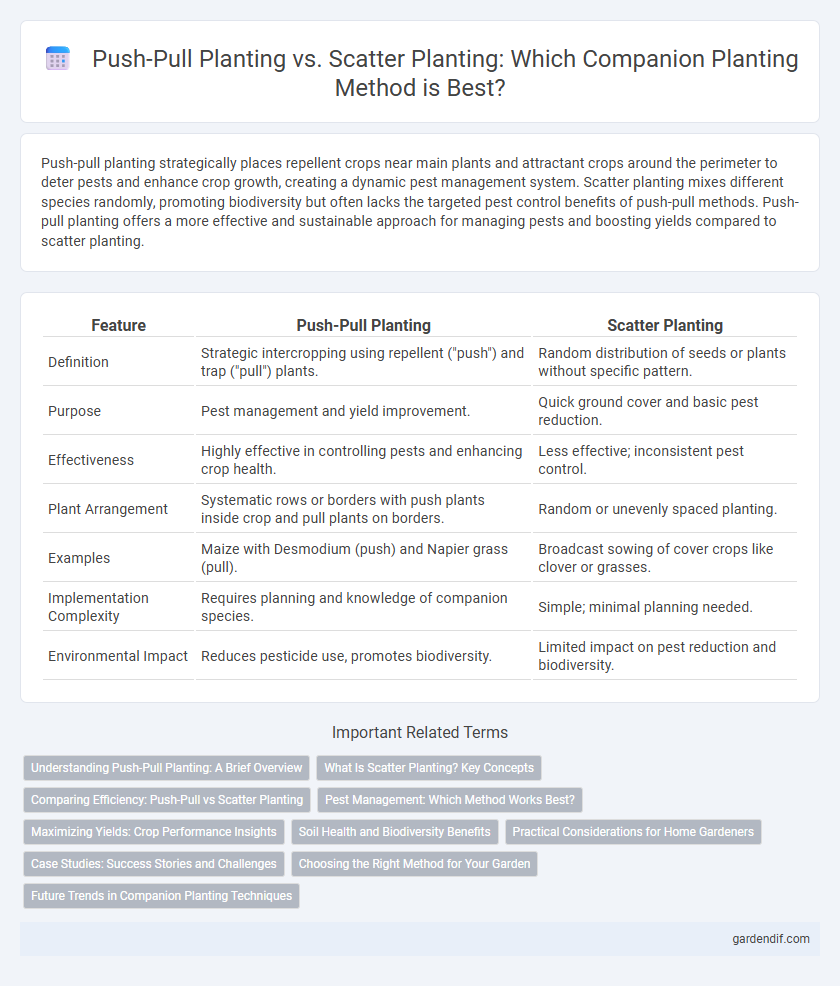
Push-pull planting vs scatter planting Illustration
Push-pull planting strategically places repellent crops near main plants and attractant crops around the perimeter to deter pests and enhance crop growth, creating a dynamic pest management system. Scatter planting mixes different species randomly, promoting biodiversity but often lacks the targeted pest control benefits of push-pull methods. Push-pull planting offers a more effective and sustainable approach for managing pests and boosting yields compared to scatter planting.
Table of Comparison
| Feature | Push-Pull Planting | Scatter Planting |
|---|---|---|
| Definition | Strategic intercropping using repellent ("push") and trap ("pull") plants. | Random distribution of seeds or plants without specific pattern. |
| Purpose | Pest management and yield improvement. | Quick ground cover and basic pest reduction. |
| Effectiveness | Highly effective in controlling pests and enhancing crop health. | Less effective; inconsistent pest control. |
| Plant Arrangement | Systematic rows or borders with push plants inside crop and pull plants on borders. | Random or unevenly spaced planting. |
| Examples | Maize with Desmodium (push) and Napier grass (pull). | Broadcast sowing of cover crops like clover or grasses. |
| Implementation Complexity | Requires planning and knowledge of companion species. | Simple; minimal planning needed. |
| Environmental Impact | Reduces pesticide use, promotes biodiversity. | Limited impact on pest reduction and biodiversity. |
Understanding Push-Pull Planting: A Brief Overview
Push-pull planting is an innovative agricultural technique that uses repellent companion plants to "push" pests away from the main crop while attractive trap plants "pull" them toward a bait area, significantly reducing pest damage. This method enhances crop yield and sustainability by promoting natural pest control without relying heavily on chemical pesticides. Scatter planting, in contrast, disperses plants randomly, lacking the strategic pest management and ecological benefits inherent in push-pull systems.
What Is Scatter Planting? Key Concepts
Scatter planting involves distributing seeds loosely over a garden bed, allowing plants to grow naturally without strict spacing, which promotes biodiversity and efficient use of space. In contrast to push-pull planting that uses strategic companion plants to repel pests and attract beneficial insects, scatter planting emphasizes spontaneous growth patterns enhancing ecosystem balance. Key concepts include seed dispersal, natural germination, and mixed species cultivation that optimize soil health and plant resilience.
Comparing Efficiency: Push-Pull vs Scatter Planting
Push-pull planting enhances pest control and crop yield by strategically placing repellent and trap plants around the main crop, optimizing plant interactions and resource use. Scatter planting disperses seeds evenly, promoting biodiversity but often lacks targeted pest management and nutrient optimization. Compared to scatter planting, push-pull offers higher efficiency through specific plant positioning that maximizes pest deterrence and nutrient sharing.
Pest Management: Which Method Works Best?
Push-pull planting excels in pest management by using repellent plants to deter pests and trap crops to attract them away from main crops, significantly reducing pest populations and damage. Scatter planting disperses crops randomly, which can confuse some pests but lacks the targeted pest suppression mechanisms of push-pull methods. Studies show push-pull planting increases pest control efficiency by creating a hostile environment for pests, making it more effective than scatter planting for sustainable pest management.
Maximizing Yields: Crop Performance Insights
Push-pull planting techniques enhance crop performance by integrating repellent plants to deter pests and trap crops to attract them, resulting in improved yield and soil health. This method contrasts with scatter planting, which disperses seeds randomly, often leading to less efficient pest management and competition among plants. Research indicates that push-pull systems significantly increase biomass and grain yields in cereal crops by optimizing resource use and reducing pest damage.
Soil Health and Biodiversity Benefits
Push-pull planting enhances soil health by strategically combining repellent and attractive plants, which reduces pest damage and promotes nutrient cycling, leading to improved microbial diversity in the soil. Scatter planting, although simpler, results in lower plant diversity and less effective pest control, potentially diminishing soil microbial communities over time. Implementing push-pull systems creates a dynamic habitat that fosters biodiversity both above and below ground, strengthening ecosystem resilience.
Practical Considerations for Home Gardeners
Push-pull planting requires strategic placement of companion plants like Desmodium and Napier grass to effectively control pests, making it ideal for gardeners with dedicated space and time for maintenance. Scatter planting offers a simpler, less labor-intensive method that disperses plants throughout the garden, which can help deter pests through diversity but may be less effective in concentrated pest management. Home gardeners should consider garden size, plant compatibility, and pest pressure when choosing between these companion planting techniques for optimal results.
Case Studies: Success Stories and Challenges
Case studies of push-pull planting reveal significant successes in pest management and crop yield enhancement, particularly in East African maize fields where Desmodium repels stemborer moths and Napier grass attracts them away. Scatter planting, widely used in diverse agroforestry systems, demonstrates improved soil fertility and biodiversity but faces challenges in maintaining plant distribution consistency and crop competition. Both methods underscore the importance of crop selection and local environmental adaptation to maximize agricultural sustainability and productivity outcomes.
Choosing the Right Method for Your Garden
Push-pull planting maximizes pest control by strategically placing repellent plants to push pests away and attractant plants to pull them toward trap crops, enhancing crop protection in confined garden spaces. Scatter planting distributes various species randomly, fostering biodiversity and reducing pest outbreaks through natural predator attraction but may require larger areas to be effective. Selecting the right method depends on garden size, crop diversity, and pest management goals to optimize plant health and yield.
Future Trends in Companion Planting Techniques
Future trends in companion planting emphasize precision methods like push-pull planting, which strategically repels pests while attracting beneficial insects to optimize crop health. Advances in sensor technology and AI-driven data analysis enable customized planting patterns that enhance plant interactions more effectively than traditional scatter planting. Integration of sustainable practices with push-pull designs is expected to increase resource efficiency and improve resilience against climate change challenges in agriculture.
Push-pull planting vs scatter planting Infographic

 gardendif.com
gardendif.com